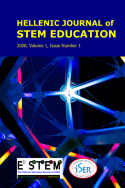Living City project: Integrating Education 4.0 content and experiences into the STEAM classroom
DOI:
https://doi.org/10.51724/hjstemed.v2i1.16Keywords:
Fourth Industrial Revolution, Education 4.0, Sustainable Development Goals, Sustainable Cities and Communities, Computer-Aided Design, STEAM, High SchoolAbstract
The World Economic Forum’s Education 4.0 initiative has identified critical characteristics of high quality learning in the Fourth Industrial Revolution, including content that fosters global citizenship, innovation, creativity, and technology skills, as well as experiences that incorporate, among others, problem-based and student-driven learning. The Living City project for high school students is presented as a demonstration of the integration of Education 4.0 characteristics into the STEAM classroom in a design-centered fashion that allows for student choice and creativity and considers the United Nations Sustainable Development Goals.
Downloads
References
Avgerinou, M. D., & Gialamas, S. P. (2016). The i2Flex Methodology: Definition, Praxis, and Conditions for Success. In Revolutionizing K-12 Blended learning through the i2Flex Classroom Model (pp. 135–159). IGI Global. https://doi.org/10.4018/978-1-5225-0267-8.ch010
Chung, V. (2020). Start with design. Stanford d.School. https://dschool.stanford.edu/resources/get-started-with-design
Deloitte (2019). Success personified in the Fourth Industrial Revolution. Four leadership personas for an era of change and uncertainty
Hawksworth, J., Berriman, R., & Goel, S. (2018). Will robots really steal our jobs? An international analysis of the potential long-term impact of automation. PricewaterhouseCooper, London.
Idin, S. (2018). An overview of STEM Education and Industry 4.0. Research Highlights in STEM Education (pp. 194-208). International Society for Research in Education and Science.
Kamsi, N. S., Firdaus, R. B. R., Razak, F. D. A., & Siregar, M. R., (2019). Realizing Industry 4.0 through STEM education: But why STEM is not preferred? IOP Conference Series: Materials Science and Engineering (Volume 506).
Karampelas, A. (2020). Developing and delivering a high school Artificial Intelligence course in blended and online learning environments. In European Distance and E-Learning Network (EDEN) Proceedings, European Distance and E-Learning Network (pp. 255-261). Academic Press.
Karampelas, A. (2021). Building a design-centered STEAM course. In Avgerinou, M.D., & Pelonis, P. (Eds.), Handbook of research on K-12 blended and virtual learning through the i²Flex classroom model. IGI Global.
Kolko, J. (2020). Design Thinking Comes of Age. Harvard Business Review. https://hbr.org/2015/09/design-thinking-comes-of-age
OECD (2020). Trustworthy artificial intelligence (AI) in education: promises and challenges.
Schwab, S. (2016). The Fourth Industrial Revolution: what it means and how to respond. https://www.weforum.org/agenda/2016/01/the-fourth-industrial-revolution-what-it-means-and-how-to-respond/
Shatunova, O., Anisimova, T., Fairuza, S., & Kalimullina, O. (2019). STEAM as an innovative educational technology. Journal of Social Studies Education Research, 10 (2), 131-144.
Sidiropoulou, M., Bakoyiannis, C., & Karampelas, A. (2021). Middle and High School Implementations of Moodle-Facilitated Blended Instructional Designs. In M. D. Avgerinou & P. Pelonis (Eds.), Handbook of research on K-12 blended and virtual learning through the i2Flex classroom model. IGI Global.
Szczepanska, J. (2019). Design thinking origin story plus some of the people who made it all happen. Medium. https://medium.com/@szczpanks/design-thinking-where-it-came-from-andthe-type-of-people-who-made-it-all-happen-dc3a05411e53
United Nations (2015). Transforming our world: The 2030 agenda for sustainable development. https://sustainabledevelopment.un.org/post2015/transformingourworld/publication
United Nations (2018). World Urbanization Prospects. The 2018 Revision. ST/ESA/SER.A/420
World Economic Forum (2020a). Schools of the Future: Defining New Models of Education for the Fourth Industrial Revolution.
World Economic Forum (2020b). Future of job survey.
Downloads
Published
How to Cite
Issue
Section
License
Copyright (c) 2022 Antonios Karampelas

This work is licensed under a Creative Commons Attribution 4.0 International License.
The copyright of articles published in the Hellenic Journal of STEM Education belong to the authors.
Published articles are subject to Creative Commons Attribution 4.0 International license.


